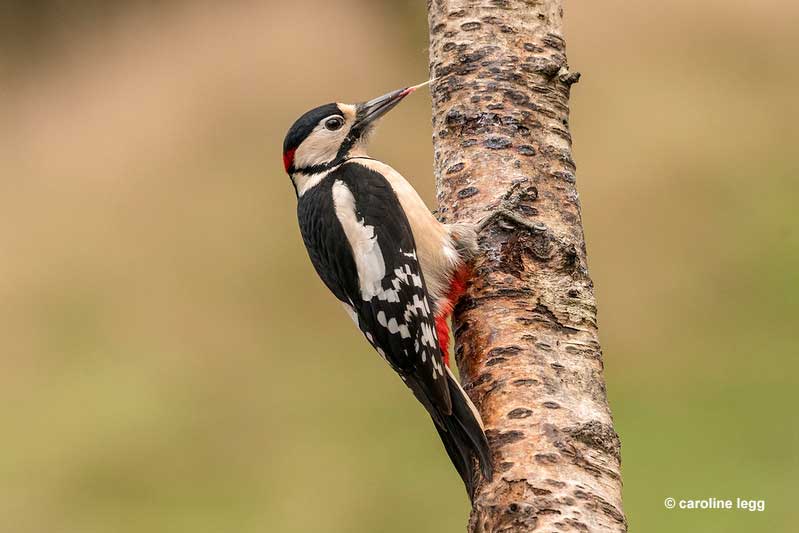
Woodpeckers are one of the most impressive backyard birds. They entertain with bold plumage, sharp avian laughter, and serious pecking abilities!
But have you ever wondered what they are pecking for? Are they looking for food, or is there another purpose? Do they eat the same things as other birds? How do they even get their food?
See answers to these and other questions about woodpeckers in this article!
Key takeaways:
- Woodpeckers are omnivores, which means they eat pretty much everything they are able to handle, this includes even fruit!
- In order to retrieve food, they often peck (some quite loudly). This is why we often hear distant drumming.
- Some species catch their food on the ground in the shape of worms, ants, and smaller insects.
On this page
The Diet of Woodpeckers
Woodpeckers are omnivorous birds that feast on a variety of insects, other small creatures, seeds, and even fruits. In general, most woodpeckers eat insects, spiders, and other arthropods that they find on and underneath bark.
Related: What kinds of seeds do birds eat?
They eat a lot of beetle grubs and other types of larvae, along with many types of bugs. While foraging on tree trunks, woodpeckers can also pick and eat various seeds and nuts. For species such as the Acorn Woodpecker, acorns are especially important.
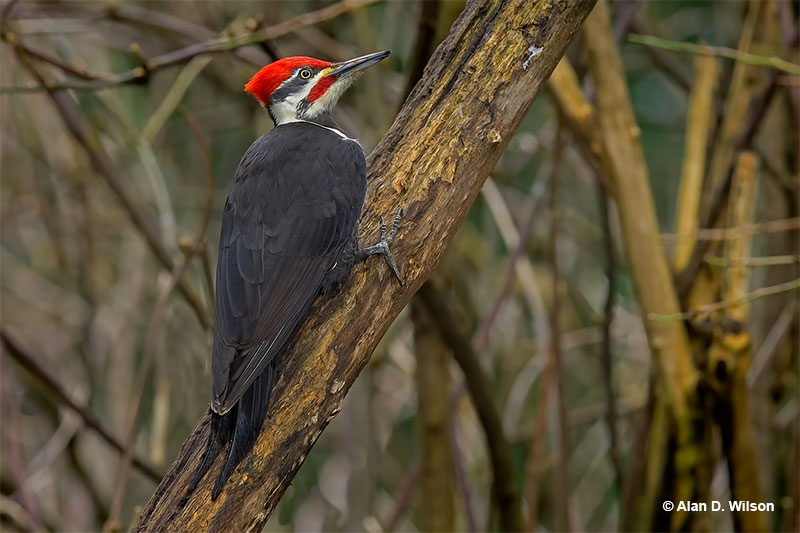
Although they find most of their insect prey on trunks and branches, some woodpeckers also fly from high perches to catch insects in flight.
When they can find them, several woodpeckers also take other small animals including small lizards, and even the eggs and nestlings of other birds.
Gila Woodpeckers are particularly opportunistic and may prey more on nestling birds than other species. These bold desert woodpeckers also take nectar from flowering cactus, and can even eat scorpions.
Some types of woodpeckers also eat more ants than others. Pileated Woodpeckers feed on Carpenter Ants, while Northern Flickers eat ants and little else. These big woodpeckers like to perch on the ground and lap up thousands of ants with their long tongues!
Insects
Woodpecker diets consist of a wide variety of insects. This type of food is extremely important for woodpeckers and they will eat just about any insect they find.
The list ranges from beetles to caterpillars. However, wood-boring insects seem to make up the largest part of their diets.
Related: Why do woodpeckers drill into wood?
Such arthropods include various species of Long-horned Beetles, wood borers, weevils, and other bugs that live in the bark and wood of trees. Small woodpecker species also eat similar types of insects that live in galls and twigs.
Woodpeckers also like to eat moths and their larvae, grasshoppers, crickets, mantids, scale insects, walking-sticks, and cockroaches.
Other commonly eaten insects include flies, mayflies, cicadas, flying ants and termites, and other flying insects. Red-headed Woodpeckers and Lewis’s Woodpeckers in particular, sally from perches to catch lots of these types of bugs.
Ants are another popular food item and are the main food for Wrynecks (a type of odd Eurasian and African woodpecker), flickers, and some other species.
Seeds & Nuts
Seeds and nuts are another vital food source for woodpeckers. Although they mostly feed on insects, without seeds and nuts, many woodpeckers would probably not survive.
Various species use this food source throughout the year but are especially dependent on seeds and nuts in the winter months. By feeding on seeds and nuts, they can capitalize on a high-energy food source when insects are absent or very scarce.
While woodpeckers often visit feeders to eat black oil sunflower seeds, peanuts, and other bits of food, they also forage for seeds and nuts in the wild. These birds have been eating nuts and seeds for many thousands of years and are very much adapted to this type of food.
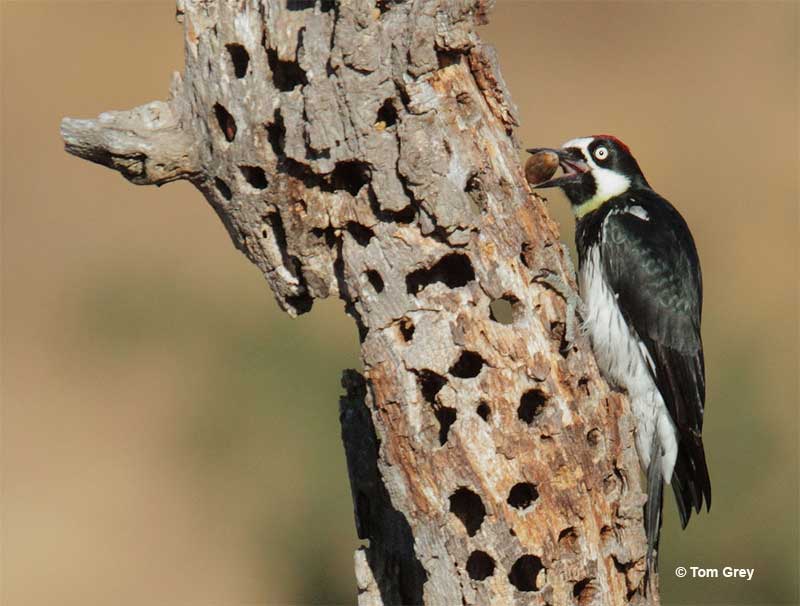
Acorn Woodpeckers are even named after their love for acorns!
Most species eat at least some seeds and nuts, but some are more dependent on them than others. True to its name, the Acorn Woodpecker in particular needs acorns and can’t live in places without them.
These industrious birds both eat acorns and store thousands of the nuts for times when other types of food become scarce. Red-bellied Woodpeckers and some other species also eat acorns.
Some of the other seed and nuts that woodpeckers feed on include Ponderosa Pine seeds (especially for the White-headed Woodpecker), pecans, hazelnuts, beechnuts, and hickory nuts.
Sap
Tree sap is another important food for woodpeckers. For some species, it’s one of their main food sources.
All four species of sapsuckers feed on sap throughout the year and Hairy Woodpeckers also take advantage of it.
They peck several shallow holes in maples and other trees so sap can ooze out of the tree and fill them. The birds both drink this sap and eat the small bugs that get stuck in it. The end result is a nutrient-rich, sugary cocktail that they rely on!
Although we find lots of trees with sapsucker holes in their northern and montane woodland breeding grounds, they also make similar rows of “sap wells” in some tropical areas. In mountainous parts of Costa Rica, I have occasionally seen trees with rows of typical sapsucker holes.
Sapsuckers are rare wintering birds in Costa Rica, but they still make their mark. Some of those trees are also very old!
Fruits & berries
Woodpeckers eat a surprising amount of fruit and berries. Although the Downy Woodpecker, Ladder-backed Woodpecker, and some other species are much more dependent on insects and seeds, some other woodpecker species eat a lot of fruit.
One of those birds is the Red-bellied Woodpecker. It can feed on fruit any time of the year but tends to eat more berries and fruit in fall and winter. Some of the species it commonly feeds on include Virginia Creeper, Greenbrier, Poison Ivy, Wild Cherry, and Dogwood.
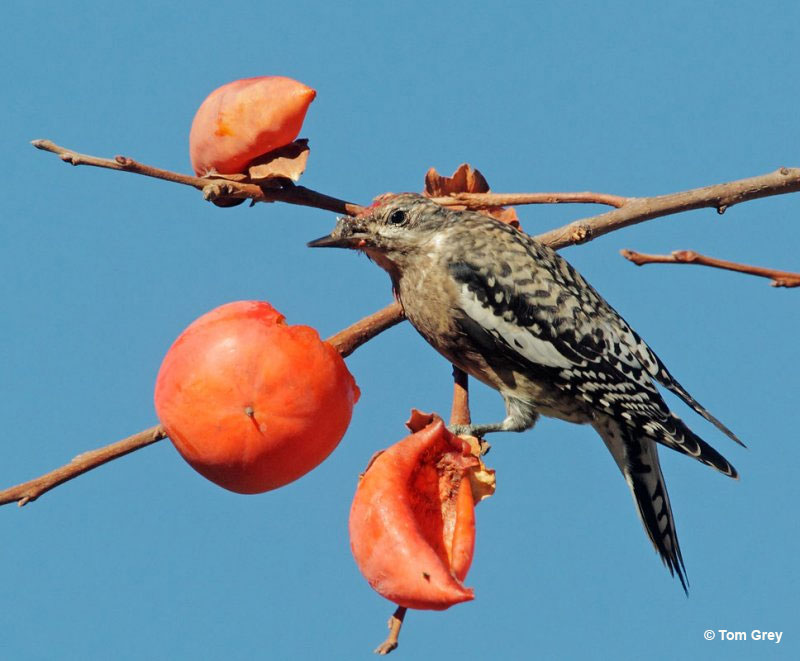
This and related species, such as the Golden-fronted Woodpecker, also peck into citrus fruits and eat soapberry, persimmon, and other types of fruit. Red-headed woodpeckers feed on these fruits, too, along with blackberries, mulberries, and apples, among other types of fruit.
Tropical woodpecker species are also heavily frugivorous and routinely visit fruit feeders to eat papaya and other fruits! They also eat lots of small berries and wild figs.
How Do Woodpeckers Retrieve Their Food?
Woodpeckers obtain their food in a few different ways. However, most species get food in the classic, well-known woodpecker way of foraging; by pecking for it.
Birds as small as the Downy Woodpecker and as large as the Pileated Woodpecker listen and watch for signs of insects. When they detect a possible bug, they peck into bark and wood to get at the insect.
To find insect prey, woodpeckers can also scale away section of bark and carve out fairly large holes. After they make an opening, they use their long tongues to probe into the holes they make as well as into crevices and tunnels made by wood-boring insects.
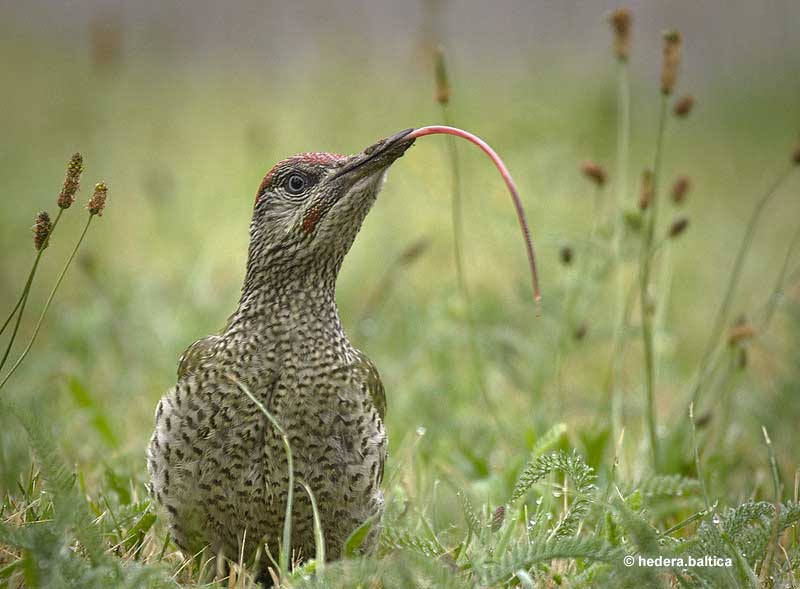
The bird’s tongue has a sharp and sticky tip that spears and traps bugs that are then brought back to its mouth.
Flickers also use their tongue in the same manner, but they mostly pick up ants from the ground and within ant nests. Woodpeckers that sally into the air to catch insects in flight use their beaks to snap up insects like a big flycatcher!
To feed on berries and fruits, woodpeckers simply perch near them and pick them with their beaks. They also use their sharp beaks to peck into eggs and kill nestlings and other small creatures.
What Do Woodpeckers Eat At Feeders?
Woodpeckers are well-known feeder birds but might not eat some of the same food as other bird species. For example, they probably won’t eat the smaller bird seed. However, Downy and Hairy Woodpeckers will happily feed on black sunflower seeds.
Most woodpeckers also eat some other types of food. In general, they prefer energy-rich foods that can provide them with similar types of nutrients and energy as their wild diets.
This is why all woodpeckers absolutely love suet. This special bird food is made of rendered fat and is often mixed with oats, cornmeal, mealworms, and other goodies! It provides woodpeckers and other birds with fantastic, energy-rich food that can help them survive cold weather.
Suet feeders do not only attract woodpeckers. You are bound to see some chickadees, nuthatches, and jays visiting the feeders too!
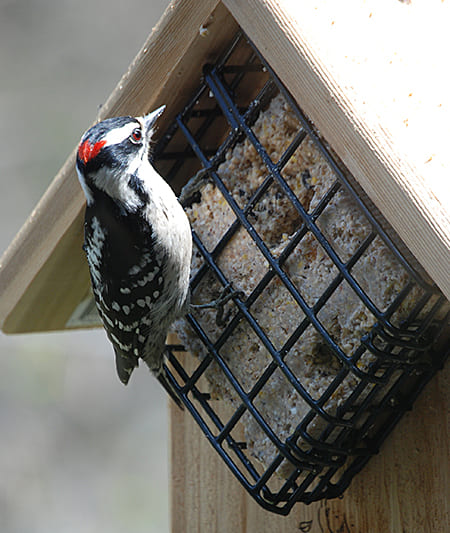
At feeders, woodpeckers really love suet. This gives them more than enough energy to survive the rougher times.
Although suet is available in easy, ready-for-use cakes, home-made suet also works just fine.
Another ready-to-use woodpecker food that you probably have in your cupboard is peanut butter! Woodpeckers will eat it along with shelled, unsalted peanuts. It’s also easy to give them peanut butter. Smear some on a tree trunk, and they’ll find it.
At feeders, you can offer them some grapes or berries. Another food that works for woodpeckers is oranges. Half them up and put some out in spring and summer, and you could attract Red-bellied Woodpeckers and related species.
What Do Baby Woodpeckers Eat?
Baby woodpeckers are fast-growing birds that need a lot of protein. Like many other baby birds, their parents bring them lots of insects and other arthropods. After catching several bugs, the parent woodpeckers go to the nest and place the food directly into the mouths of the nestlings.
They do this several times a day for at least two weeks until the baby birds leave the nest. At that time, most woodpecker species continue to feed their babies for another week or so.
In general, parents feed their babies the same type of larvae and insects that they also feed on. However, they might crush large bugs before giving them to small nestlings.
When the birds are still in the nest, their parents rarely if ever bring them seeds or nuts. However, as they grow, adult Red-headed Woodpecker do feed their babies some berries and other types of food.

